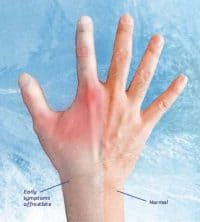The Symptoms and Stages of Frostbite
By Leanne Shelton
A few weeks ago in Phoenixville the high temperature was a mere 16 degrees. It was one of those days that when you walked outside, the insides of your nose instantly froze. Of course that is the day my kids decided they wanted to set up a tent outside and “sell their stuff.”
They didn’t understand that it was too cold to spend a lot of time outside, and it could actually be dangerous. We then talked about frostbite. I showed them pictures on the internet of people who got frostbite so bad that their skin turned black and they lost some fingers and toes. They decided they didn’t want to “get the frostbite” and gave up on the idea of playing outside.
However, it occured to me that I didn’t know what the early signs and symptoms of frostbite are. And having three littl e boys, it should probably be something that I know. So I did a little research.
e boys, it should probably be something that I know. So I did a little research.
Frostbite occurs in three stages. The first stage is first-degree frostbite, called frostnip. At this stage, your skin will turn red and feel cold to the touch. You may even feel numbness or a tingling sensation. If you notice this occurring, you should get out of the cold and rewarm the skin by soaking in warm water for 15-30 minutes. Frostnip is mild and doesn’t leave any permanent damage to the skin.
The next stage is second-degree frostbite, called superficial frostbite. In this stage, your skin will turn from red to a paler color or even white or blue. It may feel hard or frozen when you touch it. It may begin to swell and have the sensation of being warm. Your skin tissue is likely to be damaged. It is a good idea to seek medical attention at this point for help with pain and rewarming. You may also get fluid-filled blisters after your skin has warmed. Some people may experience permanent damage, which can include pain or numbness where the superficial frostbite occurred.
Third-degree frostbite, called deep frostbite, is the third stage. During this stage, skin and tissue damage occur. Skin will turn white or a splotchy blueish gray color. You may have numbness and lose all feeling of cold and pain. You may develop blood-filled blisters where the frostbite has occurred. You may also notice your muscles and joints may not work properly near the area of the frostbite. If you have deep frostbite, seek medical attention immediately for treatment. It is in this stage that you skin will turn hard and black after rewarming. Your doctor will reevaluate and determine if any further course of treatment is needed. Permanent damage is likely, which can include pain, numbness, and increased sensitivity to cold.
For more information on frostbite, contact Shoen Safety and Training. To learn CPR and First Aid and become American Red Cross certified, register for a CPR/First Aid class with Shoen Safety and Training. There are a lot of options available to fit your schedule. The peace of mind that you’ll get from knowing how to respond in an emergency situation is priceless.





